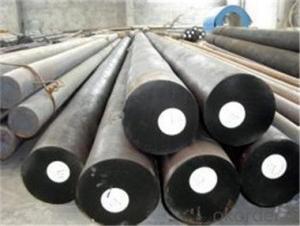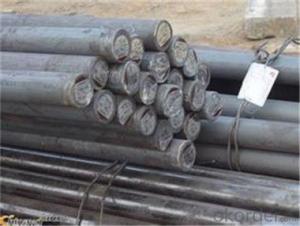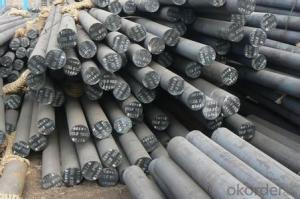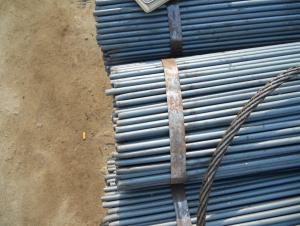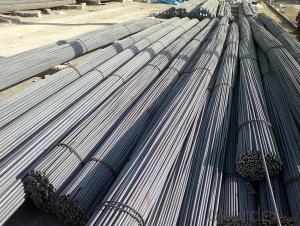Hot Rolled Carbon Steel Round Bar MS Bar -CNBM
- Loading Port:
- Tianjin
- Payment Terms:
- TT OR LC
- Min Order Qty:
- 88 m.t.
- Supply Capability:
- 2000000 m.t./month
OKorder Service Pledge
OKorder Financial Service
You Might Also Like
Description of steel round bar:
1. Commodity: Round steel bar
3. Technical: Hot rolling
2. Length: Min. 5.8meter, according to requirement.
3. Diameter: 16mm-250mm
5. Packing: In Bundle or according to your requirements.
Festures of steel round bar:
Description : Steel Bar/Stainless Steel Round Bar/Alloy Steel Round Bar/Carbon Steel Bar
Stainless Steel Bright Bar/Stainless Steel Peeled Bar/Stainless Steel Polishing Bar
Diamater:
Specifications of steel round bar:
Length: standard 6m,9m,12m, or as customers' requirement
Surface: Black, polished, grinded, ,Bright, Turn smooth(Peeled),Brush,Mill,Pickled
Process:Hot rolled,cold drawn,forged
Images of steel round bar:
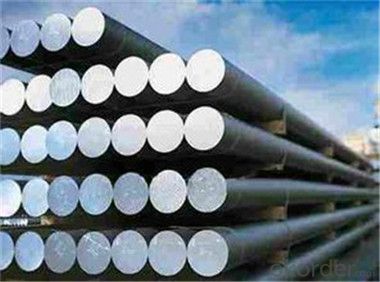
FAQ:
1. What is your main market?
We mainly export to Asia such as Japan,Korea,Thailand and North America and Middle East.
2. How long is the lead time?
Delivery time: 45 days after order confirmed.
3.Why do you choose to cooperate with us?
We have over10 years experience in this business so we are able to provide you the high quality products with the best price.
- Q:How are steel round bars tested for quality?
- To ensure that steel round bars meet the necessary standards and specifications, various methods are employed to test their quality. One commonly used test is visual inspection, which involves carefully examining the bars for any visible defects such as surface cracks, pits, or deformities. This task is carried out by highly skilled personnel who have been trained to identify irregularities that could potentially impact the quality of the steel bars. Another crucial test is dimensional inspection, which assesses the diameter, length, and straightness of the round bars. This ensures that the bars fall within the specified tolerances and meet the required dimensions for their intended use. Mechanical testing is also conducted to evaluate the strength and mechanical properties of the steel bars. This includes tests like tensile strength, yield strength, and elongation, which determine how the bars will perform under different loads and conditions. Specialized equipment is used to carry out these tests, providing important information about the structural integrity and quality of the steel bars. Moreover, chemical composition analysis is performed to verify that the steel bars have the correct proportions of various elements, such as carbon, manganese, and alloying elements. This analysis is crucial as it determines the suitability of the bars for specific applications and ensures that they possess the desired characteristics. Additionally, non-destructive testing methods, such as ultrasonic testing, magnetic particle inspection, or dye penetrant testing, may also be employed. These techniques can detect internal or surface defects that may not be visible to the naked eye, providing further confidence in the quality and integrity of the steel bars. In summary, a combination of visual inspection, dimensional inspection, mechanical testing, chemical composition analysis, and non-destructive testing methods is used to thoroughly assess the quality of steel round bars. These rigorous testing processes are essential in ensuring that the bars meet the required standards and specifications, guaranteeing customers high-quality and reliable steel products.
- Q:What are the advantages of using nickel-alloy steel round bars?
- Nickel-alloy steel round bars offer numerous benefits: 1. Superior strength and durability: Renowned for their exceptional strength and durability, nickel-alloy steel round bars can endure high levels of stress and boast excellent corrosion resistance. Consequently, they are ideal for use in demanding environments. 2. Impressive temperature resistance: With their remarkable temperature resistance properties, nickel-alloy steel round bars retain their strength and integrity even in elevated temperatures. This renders them suitable for applications in industries such as aerospace, power generation, and petrochemicals. 3. Exceptional corrosion resistance: Nickel-alloy steel round bars exhibit outstanding resistance to rust and oxidation, making them highly resistant to corrosion. This quality makes them perfect for deployment in marine environments, chemical plants, and other settings where exposure to corrosive substances is common. 4. Excellent mechanical properties: Boasting outstanding mechanical properties like high tensile strength, toughness, and ductility, nickel-alloy steel round bars can withstand heavy loads and impacts without deformation or failure. As a result, they prove suitable for use in critical structural applications. 5. Versatility and adaptability: Nickel-alloy steel round bars are easily machinable, forgeable, and weldable, offering increased versatility in manufacturing processes. They can be shaped and formed into various sizes and dimensions to meet specific requirements, making them highly adaptable to different industries. 6. Cost-effective solution: Despite their initial higher cost compared to other materials, nickel-alloy steel round bars prove to be a cost-effective choice in the long run. Their resistance to corrosion and wear minimizes maintenance and replacement expenses, resulting in significant cost savings over time. In conclusion, the advantages of nickel-alloy steel round bars lie in their superior strength, impressive temperature resistance, exceptional corrosion resistance, excellent mechanical properties, versatility, adaptability, and cost-effectiveness. These qualities establish them as reliable and efficient options for numerous applications across various industries.
- Q:Can steel round bars be used for making railway tracks?
- Making railway tracks is possible using steel round bars. They are commonly chosen as the main material for railway tracks due to their strength, durability, and capacity to handle heavy loads. These bars offer a stable and solid base for train travel and can endure the continuous wear and tear caused by train wheels. The circular shape of the bars also aids in reducing friction and enabling smooth train movement. Moreover, steel is resistant to rust, which makes it appropriate for long-lasting outdoor applications like railway tracks. In conclusion, steel round bars are a favored option for creating railway tracks because of their strength, durability, and dependability.
- Q:Can steel round bars be used in the manufacturing of machinery?
- Certainly, machinery manufacturing can make effective use of steel round bars. Various industries commonly employ steel round bars due to their robustness, longevity, and adaptability. These bars frequently serve in the fabrication of essential components like shafts, axles, gears, and other mechanical parts that necessitate exceptional strength and resistance against deterioration. Notably, steel round bars exhibit remarkable mechanical properties, encompassing impressive tensile strength and superior machinability, rendering them highly suitable for heavy-duty machinery and equipment. Furthermore, steel round bars can be conveniently welded, forged, or machined into the desired configuration, thus establishing them as a preferred option for machinery manufacturing.
- Q:What are the different surface treatments available for steel round bars?
- There are several surface treatments available for steel round bars, including: 1. Pickling and Passivation: This process involves removing impurities and oxides from the surface of the steel using an acid solution, followed by the application of a passivation treatment to enhance corrosion resistance. 2. Hot-dip Galvanizing: Steel round bars can be immersed in a bath of molten zinc, which forms a protective coating on the surface. This treatment provides excellent corrosion resistance. 3. Electroplating: This process involves applying a thin layer of metal, such as chromium or nickel, onto the surface of the steel round bar using an electrochemical method. It enhances the aesthetic appearance and provides some level of corrosion resistance. 4. Powder Coating: A dry powder is applied electrostatically to the steel round bar and then cured under heat. This results in a durable and protective coating that is resistant to corrosion, chemicals, and UV radiation. 5. Nitriding: In this treatment, the steel round bar is exposed to a nitrogen-rich atmosphere at high temperatures. This forms a hard and wear-resistant surface layer, improving the bar's performance in applications where hardness and durability are important. 6. Chrome Plating: A layer of chromium is electroplated onto the surface of the steel round bar, providing both aesthetic appeal and corrosion resistance. These are just a few examples of the different surface treatments available for steel round bars, and the choice depends on the specific requirements of the application, such as corrosion resistance, durability, and aesthetic considerations.
- Q:What are the different types of steel round bar heat treatments?
- Some common types of heat treatments for steel round bars include annealing, normalizing, quenching and tempering, and case hardening.
- Q:Can steel round bars be used in the production of sporting goods?
- Sporting goods can indeed utilize steel round bars. Steel, a versatile material renowned for its strength and durability, proves fitting for a wide spectrum of applications within the sporting goods industry. To illustrate, steel round bars can be employed to fabricate various components, including shafts, handles, frames, and supports for sporting equipment such as golf clubs, hockey sticks, weightlifting bars, and exercise machines. The robust tensile strength of steel ensures that these components can withstand the rigorous forces and pressures exerted during sports activities, thus affording stability and longevity to the resultant products. Additionally, steel round bars can be effortlessly machined, welded, and molded into different shapes and sizes to meet the particular requirements of each sporting good. Furthermore, steel's ability to resist corrosion renders it an ideal choice for outdoor sporting equipment that is subjected to diverse weather conditions. In summary, steel round bars are an immensely popular option in the production of sporting goods owing to their strength, durability, versatility, and capacity to endure the demands of various sports.
- Q:What is the reason that the diameter 130-45 round steel will break after welding?
- Steel No. 45 belongs to medium carbon steel. Because of its high carbon content, it has poor weldability, but its comprehensive property is good. If welding is needed, it needs to be preheated before welding and heat treated after welding to reduce its internal stress. The more commonly used weldability is No. 20 steel. In order to improve the performance of No. 20 steel, heat treatment is usually applied to its surface.
- Q:What are the different types of steel round bar surface finishes for improved aesthetics?
- Enhancing the aesthetic appeal of steel round bars can be achieved through various types of surface finishes. The selection of these finishes is typically based on the desired appearance and function of the steel. The following are some commonly used surface finishes for steel round bars: 1. Polished: Achieved through a series of abrasive processes, this finish results in a smooth and reflective surface. It is often utilized in applications that prioritize visual appeal, such as architectural structures or decorative pieces. 2. Brushed: This finish is accomplished by brushing the steel surface with a wire brush or abrasive pad, creating a textured look. It offers a more contemporary and subdued appearance, commonly seen in modern architectural designs or furniture. 3. Satin: Similar to brushed, this finish possesses a finer texture, producing a smooth and matte appearance. It is favored for applications that require a sophisticated and elegant aesthetic, such as luxury fixtures or appliances. 4. Hammered: This finish involves creating small dents or dimples on the steel surface, resulting in a textured and rustic appearance. It is frequently utilized in applications that necessitate a unique and artistic look, such as handrails or decorative accents. 5. Etched: Achieved through chemical treatment of the steel surface, this finish allows for intricate and detailed patterns or designs. It is popular for applications that require personalized or branded elements, such as signage or logos. 6. Powder-coated: This finish entails applying a layer of powdered paint to the steel surface, which is then baked to create a durable and vibrant coating. It offers a wide range of color options and is commonly used in applications that require both decorative and long-lasting finishes, such as outdoor furniture or architectural elements. Ultimately, the choice of steel round bar surface finish depends on the desired aesthetic outcome and the specific requirements of the application. Different finishes can enhance the visual appeal of the steel, making it suitable for a wide range of industries and design purposes.
- Q:What are the different types of steel round bar alloys for improved corrosion resistance?
- Improved corrosion resistance is associated with various types of steel round bar alloys. Stainless steel, weathering steel, and duplex stainless steel are among the commonly utilized alloys. Stainless Steel, for instance, contains a minimum of 10.5% chromium. As a result, it forms a thin layer of chromium oxide on the steel surface, serving as a protective barrier against corrosion. This protective layer significantly minimizes the likelihood of rust and other forms of corrosion. Different grades of stainless steel, such as 304 and 316, offer varying degrees of corrosion resistance based on the specific application. Weathering Steel, also known as Corten steel, acquires a rust-like appearance when exposed to the weather. This unique characteristic aids in its resistance against atmospheric corrosion. Additionally, the inclusion of copper, chromium, and nickel further enhances its corrosion resistance, allowing it to withstand harsh environmental conditions without requiring painting. Duplex Stainless Steel, on the other hand, combines austenitic and ferritic stainless steels. Its remarkable corrosion resistance is attributed to its high content of chromium and molybdenum. This type of alloy is particularly adept at combating localized corrosion, including pitting and crevice corrosion. Consequently, it finds great utility in aggressive environments like the marine and chemical industries. It is essential to recognize that the selection of a suitable steel round bar alloy for enhanced corrosion resistance hinges upon the specific requirements of the application and the surrounding environmental conditions. Seeking guidance from a materials engineer or corrosion specialist can prove beneficial in determining the most appropriate alloy for a given situation.
1. Manufacturer Overview |
|
|---|---|
| Location | |
| Year Established | |
| Annual Output Value | |
| Main Markets | |
| Company Certifications | |
2. Manufacturer Certificates |
|
|---|---|
| a) Certification Name | |
| Range | |
| Reference | |
| Validity Period | |
3. Manufacturer Capability |
|
|---|---|
| a)Trade Capacity | |
| Nearest Port | |
| Export Percentage | |
| No.of Employees in Trade Department | |
| Language Spoken: | |
| b)Factory Information | |
| Factory Size: | |
| No. of Production Lines | |
| Contract Manufacturing | |
| Product Price Range | |
Send your message to us
Hot Rolled Carbon Steel Round Bar MS Bar -CNBM
- Loading Port:
- Tianjin
- Payment Terms:
- TT OR LC
- Min Order Qty:
- 88 m.t.
- Supply Capability:
- 2000000 m.t./month
OKorder Service Pledge
OKorder Financial Service
Similar products
New products
Hot products
